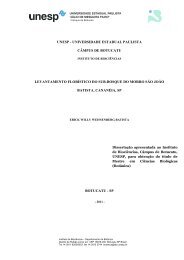- Page 1 and 2:
UNIVERSIDADE ESTADUAL PAULISTA UNES
- Page 3 and 4:
FICHA CATALOGRÁFICA ELABORADA PELA
- Page 5 and 6:
“Só é inabalável a fé que pod
- Page 7 and 8:
Dedicatória “É na educação do
- Page 9 and 10:
Agradecimentos ....................
- Page 11 and 12:
Agradecimentos Aos professores Dr.
- Page 13 and 14:
Agradecimentos Aos funcionários e
- Page 15 and 16:
Agradecimentos Aos meus queridos Ir
- Page 17 and 18:
Índice ‣ SALINIDADE.............
- Page 19 and 20:
Resumo inverno e no transecto 6, en
- Page 21 and 22:
Abstract summer and beginning of th
- Page 23 and 24:
Considerações Iniciais CONSIDERA
- Page 25 and 26:
Considerações Iniciais Estudos co
- Page 27 and 28:
Introdução & Objetivos INTRODUÇ
- Page 29 and 30:
Introdução & Objetivos caracterí
- Page 31 and 32:
Introdução & Objetivos suspensos
- Page 33 and 34:
Introdução & Objetivos estuarinos
- Page 35 and 36:
Introdução & Objetivos pela Porta
- Page 37 and 38:
Introdução & Objetivos climática
- Page 39 and 40:
Introdução & Objetivos Os camarõ
- Page 41 and 42:
Introdução & Objetivos Rulifson,
- Page 43 and 44:
Introdução & Objetivos Segundo Sa
- Page 45 and 46:
Introdução & Objetivos neste loca
- Page 47 and 48:
Introdução & Objetivos Os três p
- Page 49 and 50:
Introdução & Objetivos conhecimen
- Page 51 and 52:
Material & Métodos MATERIAL & MÉT
- Page 53 and 54:
Material & Métodos Segundo Castro-
- Page 55 and 56:
Material & Métodos Figura 4. Vista
- Page 57 and 58:
Material & Métodos Figuras 6 e 7.
- Page 59 and 60:
Material & Métodos Figura 11. Barc
- Page 61 and 62:
Material & Métodos VARIÁVEIS AMBI
- Page 63 and 64: Material & Métodos Determinação
- Page 65 and 66: Material & Métodos populacionais,
- Page 67 and 68: Material & Métodos Tabela 2. Coord
- Page 69 and 70: Resultados Capítulo 1
- Page 71 and 72: Capítulo 1 - Resultados 35 ES [ 1
- Page 73 and 74: Capítulo 1 - Resultados BA (porç
- Page 75 and 76: Capítulo 1 - Resultados 40 BA 35 S
- Page 77 and 78: Capítulo 1 - Resultados 30 BC 28 T
- Page 79 and 80: Capítulo 1 - Resultados BA (porç
- Page 81 and 82: Capítulo 1 - Resultados ABUNDÂNCI
- Page 83 and 84: Capítulo 1 - Resultados O número
- Page 85 and 86: Capítulo 1 - Resultados F. brasili
- Page 87 and 88: Capítulo 1 - Resultados não difer
- Page 89 and 90: Capítulo 1 - Resultados F. brasili
- Page 91 and 92: Capítulo 1 - Resultados F. paulens
- Page 93 and 94: Capítulo 1 - Resultados Farfantepe
- Page 95 and 96: Capítulo 1 - Resultados Tabela 8.
- Page 97 and 98: Capítulo 1 - Resultados ‣ BC (re
- Page 99 and 100: Capítulo 1 - Resultados Tabela 9.
- Page 101 and 102: Capítulo 1 - Resultados F. paulens
- Page 103 and 104: Capítulo 1 - Discussão DISCUSSÃO
- Page 105 and 106: Capítulo 1 - Discussão ano, e des
- Page 107 and 108: Capítulo 1 - Discussão se estabel
- Page 109 and 110: Capítulo 1 - Discussão As diferen
- Page 111 and 112: Resultados Capítulo 2
- Page 113: Capítulo 2 - Resultados F. brasili
- Page 117 and 118: Capítulo 2 - Resultados período d
- Page 119 and 120: Capítulo 2 - Resultados 1º ano F.
- Page 121 and 122: Capítulo 2 - Resultados JULHO 2005
- Page 123 and 124: Capítulo 2 - Resultados JULHO 2006
- Page 125 and 126: Capítulo 2 - Resultados JULHO 2005
- Page 127 and 128: Capítulo 2 - Resultados JULHO 2006
- Page 129 and 130: Discussão Capítulo 2
- Page 131 and 132: Capítulo 2 - Discussão tratar de
- Page 133 and 134: Capítulo 2 - Discussão O período
- Page 135 and 136: Capítulo 2 - Discussão vida ocorr
- Page 137 and 138: Capítulo 3 - Resultados RESULTADOS
- Page 139 and 140: Capítulo 3 - Resultados Farfantepe
- Page 141 and 142: Capítulo 3 - Resultados F. brasili
- Page 143 and 144: Capítulo 3 - Resultados F. paulens
- Page 145 and 146: Capítulo 3 - Resultados F. brasili
- Page 147 and 148: Capítulo 3 - Resultados F. paulens
- Page 149 and 150: Discussão Capítulo 3
- Page 151 and 152: Capítulo 3 - Discussão No estudo
- Page 153 and 154: Capítulo 3 - Discussão as porçõ
- Page 155 and 156: Considerações Finais
- Page 157 and 158: Considerações Finais Com relaçã
- Page 159 and 160: Referências Bibliográficas
- Page 161 and 162: Referências Bibliográficas Bertin
- Page 163 and 164: Referências Bibliográficas Costa,
- Page 165 and 166:
Referências Bibliográficas D'Inca
- Page 167 and 168:
Referências Bibliográficas Haywoo
- Page 169 and 170:
Referências Bibliográficas Macia,
- Page 171 and 172:
Referências Bibliográficas Negrei
- Page 173 and 174:
Referências Bibliográficas Silva,
- Page 175 and 176:
Referências Bibliográficas Wasiel
- Page 177 and 178:
Apêndice Apêndice 1. Valores abso
- Page 179 and 180:
Apêndice Apêndice 3. Valores méd
- Page 181 and 182:
Apêndice Apêndice 5. Valores méd
- Page 183 and 184:
Apêndice Apêndice 7. Valores méd
- Page 185 and 186:
Capítulo 1 - Resultados Apêndice
- Page 187 and 188:
Apêndice Apêndice 11. Número de
- Page 189 and 190:
Apêndice Apêndice 13. Resultado d
- Page 191 and 192:
Apêndice Apêndice 15. Número de
- Page 193 and 194:
Apêndice Tabela 17. Resultado do t
- Page 195 and 196:
Apêndice Apêndice 19. Número de
- Page 197 and 198:
Apêndice Apêndice 21. Número de
- Page 199 and 200:
Apêndice Tabela 23. Resultado do t
- Page 201 and 202:
Apêndice Apêndice 25. Resultado d
- Page 203 and 204:
Apêndice Apêndice 27. Número de
















